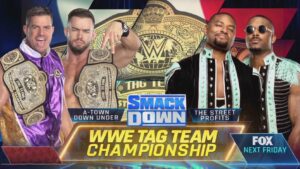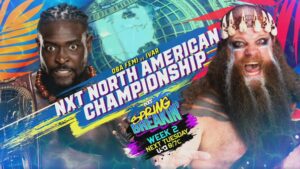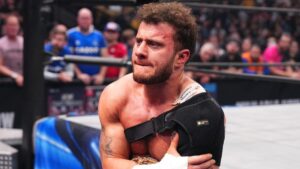On April 16, 1994, in Tokyo, Japan, there arrived a wrestling summit of huge consequence. The brainchild of New Japan Pro Wrestling‘s Jushin ‘Thunder’ Liger, then an emerging star in New Japan’s young Junior Heavyweight division (it was less than a decade old, having been started in 1986). Liger, at the time in his sixth reign as IWGP Junior Heavyweight Champion, wanted to showcase all the best junior heavyweights in Asia and North America, at a time when wrestling was still perceived as being for the “big boys”. His vision became the first ever Super J-Cup, a 12-man tournament featuring multiple promotions, and it was on this day 25 years ago, that the first Super J-Cup ran at the Sumo Hall in Tokyo. Here’s a look at the wrestlers and promotions featured at the inaugural event, first hosted by NJPW.
Black Tiger (Eddie Guerrero), NJPW

While he wrestled as Eddie Guerrero in North America with his family legacy behind him, in New Japan Pro Wrestling, he wrestled under a mask as Black Tiger, taking over from the original Black Tiger, UK wrestler Mark “Rollerball” Rocco. While he was developing his future Latino Heat swagger as part of the tag team with “Love Machine” Art Barr, in Japan he got to perfect his high flying lucha libre with technical mat wrestling in anonymity. It wasn’t long after the first Super J-Cup that his abilities in both sides of the world were noticed in the US, first by ECW, and then soon after, to WCW. The rest is history.

Dean Malenko, NJPW

Dean Malenko had spent five years with All Japan Wrestling from 1988 to 1992, before he jumped to New Japan in 1992, where his no-nonsense, physical technical style was a throwback to gaijin legends like Karl Gotch and Billy Robinson. Much like several of the performers in this group, he joined ECW shortly after the tournament and then headed to WCW where he became a Four Horseman. One of the most underrated technical grapplers of the past thirty years.

El Samurai, NJPW

A New Japan Young Lion from the 1986 class, El Samurai has a 24-year career in NJPW until he departed in 2010 as a former IWGP Junior Heavyweight Junior Champion, 3x IWGP Junior Heavyweight Tag Team Champion and 2x J-Crown Champion. He would freelance for three more years before retiring in 2013.

Gedo, Wrestle Association-R (WAR)

He’s best known today as the loudmouth hypeman for Bullet Club, but Gedo was part of one of the greatest junior heavyweight tag teams in Japan alongside Jado. A New Japan Young Lion in 1989, he was sent to Mexico’s Universal Wrestling Association (UWA) on an excursion. Gedo (and Jado) didn’t return to New Japan, instead heading to more rogue promotions like Wrestling International New Generations (WING), Frontier Martial-arts Wrestling (FMW), and Wrestle Association-R (WAR), the promotion he represented. Gedo finally returned to New Japan in 2001, where he’s remained to this today, taking over as one of their creative heads and remaining an active irritant in the top storylines.

Hayabusa, Frontier Martial-arts Wrestling (FMW)

Considered to be one of the most innovative high flyers to ever come out of Japan, Hayabusa was like someone with Jushin Liger’s mind and creativity and Sabu‘s body and reckless abandon. A pioneer for so much of the aerialist techniques and moves seen today around the world, he was a staple with FMW and a 3x FMW Double Champion (their top title), who also appeared with CMLL, ECW and All Japan. He was just entering his prime in 2001 when a tragic mishap during a match left him paralyzed. There’s no doubt that had he remained healthy, he would have been an impact player in the rise of the indies with the likes of Pro Wrestling Guerrilla (PWG), Ring of Honor and CHIKARA on the verge of foundation. Sadly, Hayabusa passed away in 2016, after only recently regaining the ability to walk after spending over a decade paralyzed from the in-ring accident.

Jushin Thunder Liger, NJPW

The biggest star in Japan in the tournament and the reigning 6x IWGP Junior Heavyweight Champion, he was the shining star of the host promotion, New Japan, and the odds on favorite to win the whole thing. And even though the tournament was his idea, not many would have argued with the booking of Liger winning the inaugural event. But as the world found out, Liger would get knocked out in the Semi-Finals to a Japanese rival, opening the tournament up to anyone. Liger has become a part of pro wrestling’s lore, an integrated part of its fantastical reality, that it will be hard to imagine a wrestling landscape that doesn’t have a Jushin Thunder Liger in it when he retires in early 2020.

Masayoshi Motegi, Wrestling International New Generations (WING)

A product of WING, Motegi made his debut with the promotion in 1991. Several years later, he would find great success in Puerto Rico with World Wrestling Council (WWC), where he became a 4x WWC Junior Heavyweight Champion (he had actually just lost his fourth title days before the tournament). In 1993, he worked for CMLL in Mexico and ECW in the US, and after the Super J-Cup, he left WING for WAR. He stayed with WAR until 1996, before splitting time with Big Japan Wrestling (BJW) and Michinoku Pro Wrestling (MPW). In 2003, he joined Pro Wrestling ZERO1. He would freelance for the remainder of his career, finally retiring in August of 2018. His most famous contribution to pro wrestling lore is that he was the first man to use the Rolling German Suplexes that have since become a staple in wrestling, from Brock Lesnar to Eddie Guerrero’s own “Three Amigos”.

Negro Casas, Consejo Mundial De Lucha Libre (CMLL)

In 1994, there were few active luchadors with as much international appeal as CMLL’s Negro Casas. A gifted storyteller and marvel in the ring, he was a 15-year pro when he competed in the Super J-Cup and former UWA World Middleweight and Lightweight Champion. Negro Casas still competes for CMLL, 25 years later, and now has a trophy case that includes 6x CMLL World Tag Team Championships, 2x CMLL World Welterweight Championships, and a CMLL World Middleweight Championship.

Ricky Fuji, FMW

Ricky Fuji was a New Japan Young Lion in the class of 1984 and in 1987, went to Calgary, Alberta, Canada on an excursion where he spent time with Stampede Wrestling, training with Stu Hart. He trained alongside the likes of Owen Hart, Chris Benoit, and countrymen like Jushin Liger and Masa Chono. But when he returned to Japan, he joined FMW in 1990 and became the World Light Heavyweight Champion. In 2001, he jumped to fellow FMW star Hayabusa’s new promotion, Wrestling Marvelous Future, where he remained until its closing in 2008. He worked for Pro Wrestling FREEDOMS for a few years, before becoming a regular with KAIENTAI DOJO in 2011 (he’d freelanced with them for years prior), where he still competes today.

Shinjiro Otani, NJPW

Shinjiro Otani was practically still a Young Lion when he appeared in the Super J-Cup, having only made his debut in 1992. But following his strong showing, he became a new star in New Japan’s Junior Heavyweight division, a 2x J-Crown Champion and IWGP Junior Heavyweight Champ. He was even an early star in WCW’s Cruiserweight division, appearing for WCW from 1994 through 1996. In 2001, he jumped to ZERO1, and by 2004 had bought into ownership. He remains ZERO1’s biggest legend and the past few months has begun wrestling big matches in the US, reigniting interest in the Japanese legend.

Super Delfin, Michinoku Pro Wrestling (MPW)

In 1989, Super Delfin debuted in NJPW as part of the infamous Takeshi Puroresu Gundan stable, the short-lived faction lead by Japanese comedian Takeshi Kitano that introduced Vader to Japan. But New Japan had no further use for him outside the stable as comedic effect more than anything, so he soon left for other pastures. He bounced around from FMW in Japan to Mexico (where he adopted the masked persona Super Delfin), before returning to Japan in 1993 with Michinoku Pro as a 3x UWA World Welterweight Champion. In 1999 he headed back to Mexico, this time with CMLL becoming a 2x CMLL World Welterweight Champion, and starting his own promotion, Osaka Pro Wrestling (OPW) in 1999. He sold OPW in 2008, starting up Okinawa Pro Wrestling that year. Since he sold Okinawa Pro in 2012, he continues to freelance around Japan.

Taka Michinoku, MPW

A student of The Great Sasuke, Taka Michinoku debuted with the promotion he’s named after, Michinoku Pro Wrestling, in 1992 (it was a sign of respect to his teacher, who owned MPW). He was just a budding prospect when he appeared as MPW’s representative at the first Super J-Cup. By 1997, he was one of the most exciting new stars in Japan and signed with the WWE for their rebooting Light Heavyweight division. He held the WWF Light Heavyweight title for 315 days, but after losing it, was used more in comedic spots than anything. He left the WWE in 2001 and returned to Japan, where he founded KAIENTAI DOJO, a promotion he still runs and owns. In 2011, he joined New Japan full time as a part of Suzuki-gun, a position he maintains to this day.

Wild Pegasus, NJPW

No one expected the Canadian star to win the whole thing, but on April 16, 1994, the newly unmasked Wild Pegasus (formerly the masked Pegasus Kid) did just that. Although perhaps they were blinded by the allure of Liger, because Pegasus was still a top contender – after all, he’d won the Top of the Super Juniors tournament (the pre-cursor to Best of the Super Juniors) only the year before, and was a former IWGP Junior Heavyweight Champion himself. It would prove to be his last hurrah with New Japan, as he returned to North America under his real name, Chris Benoit, to work for ECW alongside fellow tournament competitors, Dean Malenko, and Eddie Guerrero. The three would be forever intertwined, joining WCW soon after that, then WWE in 1999. Eddie and Benoit would both become World Champions in the WWE, while Dean Malenko would become a 2x WWE Light Heavyweight Champion, with his second reign lasting 322-days. Malenko would retire in 2001, having been a champion in the WWE for nearly 50% of his tenure there. He remains with the WWE in a producer/agent capacity.

The have been five more Super J-Cups since the first one launched in 1994. In 1995, WAR hosted the second one, while the third took place five years later in MPW in 2000 – both were won by its creator, Jushin Liger. It returned in 2004, hosted by OPW, which saw Pro Wrestling NOAH‘s Noamichi Marufuji win, who repeated again in 2009, when NJPW hosted again. New Japan held the last one and sixth overall in 2016, which was won by recently departed KUSHIDA.






